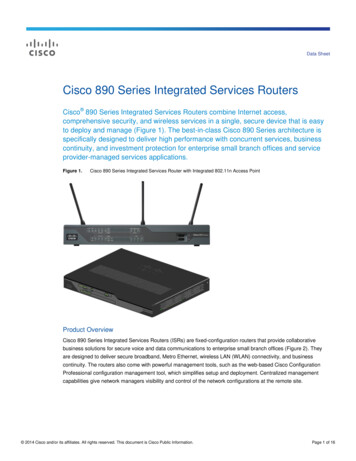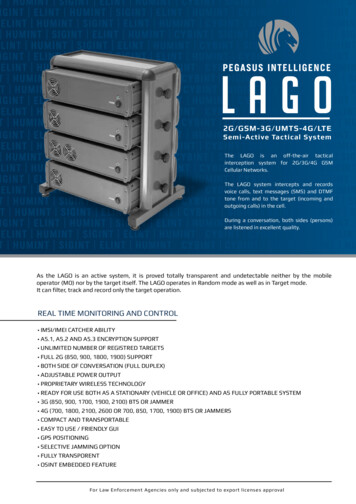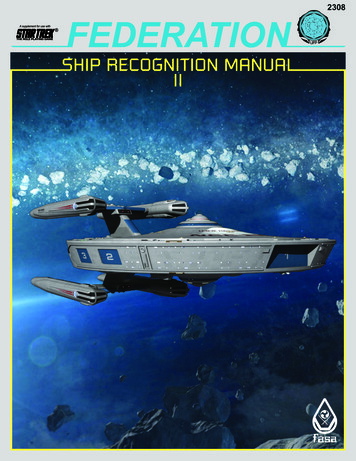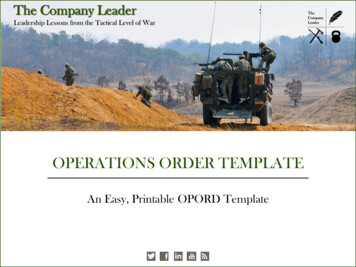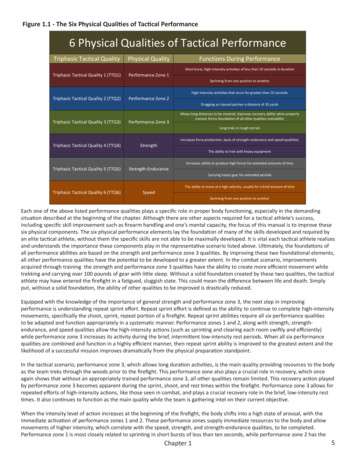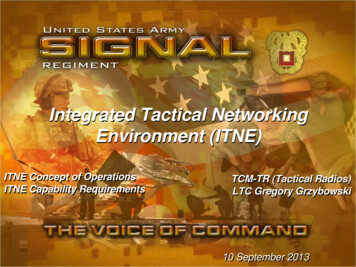
Transcription
Integrated Tactical NetworkingEnvironment (ITNE)ITNE Concept of OperationsITNE Capability RequirementsTCM-TR (Tactical Radios)LTC Gregory Grzybowski10 September 2013
UNCLASSIFIEDAgenda Purpose ITNE Imperatives ITNE Capability Development Methodology ITNE Complexity ITNE Concept of Operations ITNE Planning Process ITNE Management Process ITNE Analysis Process ITNE Unit Task Reorganization (Appendix K) ITNE Dependencies ITNE Troop to Task List QuestionsUNCLASSIFIED
UNCLASSIFIEDPurposeProvide an overview of the ITNE Concept ofOperations (CONOPS) with an emphasis onSignal Planning, Management, and AnalysisProcessesUNCLASSIFIED
UNCLASSIFIEDITNE Imperatives Ensure the materiel integration of all radio platforms,waveforms, mobile/mounted mission command applicationmanagement, ancillary devices and associated NetworkOperations (NetOps) Management software capabilities Ensure the integration and interoperability of networkoperations between Joint, Interagency, Multinational, ArmyUpper Tactical Internet (UTI) and ITNE capabilities Ensure the proper development, integration, and sustainment ofcomprehensive ITNE training for the S-6 staff Ensure the development of an ITNE Concept of Operations(CONOPS) to support the ITNE IS CDD, NIE, Capability SetFielding process, Force Structure Analysis, and PersonnelAlignmentUNCLASSIFIED
ITNE Capability DevelopmentMethodologyUNCLASSIFIEDIndividual System NETSA/DPSA/DP NET16 hrs.2 sessionWIN-T Inc 2 (BCT)TCN-OM320 ( 80 hrs. crew drills)1 session40 hrs. (1 day IB training;1 session 80 hrs. crew drills)40 hrs. (1 day IB training; Up to 20 students per min 66 (2 per CI); 80 hrs. crew drills) session. 4 sessions.max 8024 hrs. (1 day IB training;1 session20 (2 per CI) 80 hrs. crew drills)Staff Overview2-4 hrs.IB System NET6-8 hrs.Integrated Bridge (forWIN-T Inc 2 KLVs)TCN-OMNETOPS(NOSC-D)JGN525Q, 25SBde HQ1 session19 (2 25S STT BCTlevel, 2 per TRT)25Q, 25SBde HQ1 session1-20Senior LeadershipBde, BnSTT Delta CourseYESYESYESYESYESYESNoneNO YES YES 25NDivSee NMIB and MFP.YESDivYESGPU (Vehicle Crew)Div2025U, 25B, 254A, 255A, 255NDivDriver training onplatform.Driver training onplatform. CPP NET for CPPVWPs.Driver training onplatform.1 sessionmin 9; max 1025Q, 25SDivSTT Delta CourseYES1 sessionmin 9; max 1025Q, 25SDivSenior LeadershipBde, Bn1 session1 session1-20min 1; max20MC13 Mission Command TMC Battle Staff/BasicWork Station (MCWS) Operator Course(AKA TMC Client)40 hrs.Enough courses to train2.5 users per box; 120pax4-2016 hrs.1 session5-20MC 13 (TMC Server System AdministratorSuite/BCCS)(Server)MC 13 Command Web Basic Command Web80 hrs.1 sessionMax 58 hrs.7 session (if necessary;web enabled laptopusers without C2 box)20MC 13 Command WebCommand WebEngineer Course16 hrs.1 session20Command Web CIRS16 hrs.JTNTJTNT OPNET80 hrs.NETT WarriorNET Warrior OPNET40 hrs per sessionAN/PRC-154ARifleman RadioOperatorCOMSEC Key andPreset Loading8 hrs.AN/PRC-155 ManpackOperatorAN/PRC-155(Manpack) FLMNET16 hrs.Bde HQ4 hrs.24 hrs202 sessionsMax 20NoneYESNoneYESGPU of the Command Web Bde HQ, Bnenvironment. Disadvantagedusers. Users who have noavailability to C2 in CP.NoneYESBDE and BN Engineer officers Bde BnNoneYES Enough sessions to train100% NETT Warrior EUDand 20% of RR only user.4 sessions (2 per day for2 days)YES10 YES15 IBCT: 16 sessions total (4 min 15; max 60 All leaders/Soldiers identified In Co, CAV Soldiers already trained onsessions per week in(through BOIP) to receive Nett TrpAN/PRC154Aparallel; 4 weeks total);Warrior system (generally TLSBCT 20 sessions (4and above)sessions per week inparallel; 5 weeks total)4 sessions (40 totaltrained) YESYESmax 10 NOYESCBRN BDE and BN Officers and Bde, BnNoneNCO25A, 25C, 25E, 25N (BN/BDE), Bde, Bn Soldiers already trained on255NAN/PRC154A and AN/PRC155 (working on addingNETT Warror Maint/SigBlock to JTNT)Max 20 YESTTPs1 session YESYESBde/Bn Cdr/XO, S3, key staff Bde HQ, BnNoneleadersGeneral Purpose CPOF users at Bde HQ, Bn Entry level training forBDE and BN (25B Bn/Bde StaffSoldiers with no previousOfficer/Warrant Officer/NCO)experience. Also, serves asthe prerequisite CPOFtraining to otherWarfighting Functions(WFFs) (FIRES, LOG, etc.)CPOF courses underCollapse/Convergencestrategy.25B at Bn/Bde responsible for Bde HQ, BNNonemaintaining/configuring CPOFBde 53A, 255A, 25B YESGPU (Vehicle Crew)min 4 (2 per CI)'max 6min 6 (2 per CI);max 10min 4 (2 per CI);max 61 session1 sessionMC 13 Command Web ITNE OntologyUser Support Course 200 hrs. (1 day IB train-ingto target MOS 25U; 480hrs. crew drills)Transmission64 hrs. ( 80 hrs. crewOperator/Maintainerdrills)CourseSTT Delta40 hoursTMC MaintainerCourseYES IB System NET held20WIN-T Inc 2 KLV TC/operator. Bde, Bn, Co MRAP driver trainingimmediately prior toNot intended for drivers.WIN-T Inc 2 PoP, SNE.Attendees of WIN-T Inc 2 PoP,VWP and User SupportSNE, VWP and User SuportCoursesCourses.320 ( 80 hrs. crew drills)1 sessionMin 6 (2 per CI);25NDiv FMTV drivers training. (SeeMax 9NMIB and MFP fortechnical requirements)320 ( 80 hrs. crew drills)1 sessionmin 17; max 20 25B(6). 25E (2), 25N (2), 25Q DivSee NMIB and MFP.(1), 25S (2), 25W (2), 250N (2),251A(1), 254A(2), 24A (1), 25A(4), 53A(2)Two sessions offeredAN/PRC-155Organization194 hrs.S-6 Troop to TaskKey Leader Training1 session2-4 hrs.AN/PRC 154AForce StructureAlignment25U, 25B, 254AStaff OverviewMC 13 (MCWS and TMCGateway)GPU (Vehicle Crew)20Key Leaders OverviewMC 13GPU (Vehicle Crew)See NMIB and MFP.Driver training onplatform.CoDriver training onplatform.Bde, BnDriver training onplatform. CPP NET for CPPVWPs.Bde, Bn, Co MRAP driver training.1 session1 sessionVWPFutureSIGCoE(FAA)1 session176 hrs ( 80 hrs crewdrills)40 hrs. (1 day IB training; 80 hrs. crew drills)24 hrs. (1 day IB training; 80 hrs. crew drills)PoP UserPersonnel SkillSet AlignmentYESPoP UserUser Support Course 200 hrs. (1 day IB train-ingto target MOS 25U; 480hrs. crew drills)Transmission64 hrs. ( 80 hrs. crewOperator/Maintainerdrills)CourseSTT Delta40 hoursWIN-T Inc 2 (Div)min 17; max 20 25B (8), 25E (1), 25N (1), 25Q Bde HQ(1), 25S (1), 25W (1), 250N (1),254A(1), 25A(1), 53A(1), 255S(1), 255N (1) (FROM MER 26 Jul12)14 (2 per CI)GPU (Vehicle Crew)Bn320 ( 80 hrs. crew drills)VWPSIGCoE CGApproved12 Aug 2013YESNETOPS(NOSC-B)SNE UserITNEManpowerEstimateReport(MER)Min 2 ; Max 8 25A, 25B, 25C, 25W, 53A, 250N, Bde HQNone251A, 254A, BTL CPTs, 25U incharge of LTI planning25NBde HQ, Bn FMTV drivers training. (SeeNMIB and MFP fortechnical requirements)min 16 (2 per CI);max 24 (3 per CI)GPU. No MOS or echelon Bde, Bn, CorequirementsGPU. SKL operators.CoGPUBde, Bn, Co Complteted AN/PRC 154AOPNET; COMSEC Accesslist; SECRET Clearance25U (Co Commo Sgt, Bn and Bde, Bn, Co AN/PRC-155 ManpackBde Retrans, Bn S6 25U, 25U10Operator NETand 25U20 at BDE); other 25series depending on position;other MOS retrans YES JCIDSIT Box Approach YES YES NETDoctrine/Personnel/TrainingMaterielUNCLASSIFIED
ITNE ComplexityCS 13 CNR-to-ITNE Core EvolutionUNCLASSIFIEDRPSCS 12 and Earlier (CNR)Radio PlatformsElement ManagersCS 13 and Beyond (ITNE)RadioPlatformsRifleman RadioJACS/ACESHFWFSoftwareSRWSidehatVendor Tactical Router 1WNWANW2NetworkManagementSystemTactical Router 2CDS 1UHFSATCDS 2117GPlan and LoadPlan, Load, Manage, and MonitorComplexity Growth – IBCT CORadio Waveform 1 (SINCGARS)Radio Platforms 5Loadsets 4-8Radio Total 37 RadiosSecurity Enclave 1* This depiction reflects a moment and time and doesnot represent the objective end state for an IBCT6Radio Waveform 4 (SRW/WNW/ANW2/SINCGARS)Radio Platforms 8Loadsets 50 (RR) / 100 (MP)Radio Total 140-150Security Enclaves 2Tactical Router Total 6CDS 4UNCLASSIFIED
ITNE Complexity(SDR Platform LayerRadio PlatformDevelopersMission CommandApplication LayerSoftwareEngineeringCTR (SEC)(NettWarrior & Mobile Apps)FBCB2 - SILWaveform Application LayerBoeingInformation ElementsIP ranges & assignmentmulticast groupsunit reference numbers (URNs)role nameswaveform preset assignmentsvoice call group assignmentsAreas of theon(SINCGARS/SRW/Mid-Tier)OSINetworkingand LinkState LayerHarrisRadio Operating System(OS)SystemDesignHarristypes of parametersparameter settings IPhysicalLayerRadio Physical LayerArmyProcessReqExelisGeneralDynamicsMemory CapacityChip DesignMotherboard circuitryTransmission subsystemArmyProcessReqSystemDesign* Additional ITNE components not illustrated in this depiction include routers, cross domain solutions, gateways, mission commandmobile/mounted applications, networked and non-networked ancillary devices, and the Network Operations (NetOps) system7UNCLASSIFIED
ITNE Complexity(NetOps Processes)J-TNTJ-TNT
UNCLASSIFIEDITNEConcept of Operations9UNCLASSIFIED
UNCLASSIFIEDITNE Concept of Operations(CONOPS) - DevelopmentCapability Set and ONS FieldingLessons LearnedONSONS173rd ABCT75th Ranger RGTTTPsCS 1310th MTN DIVEmerging ConceptsCS 13CS 13CS 13101st DIV3rd ID1st ADTest and EvaluationLessons LearnedNIE 11.2NIE 12.1TTPsNIE 12.2Emerging ConceptsNIE 13.1NIE 13.2DoctrineLessons LearnedSignal OperationsFM 6-02.43TTPsArmy Enterprise NetOps CONOPSNetOps CONOPSEmerging ConceptsArmy PlanningFM 101-5Army OperationsFM 3-0UNCLASSIFIED
UNCLASSIFIEDITNE Concept of Operations(CONOPS) - ContentCONOPS highlights the interdependencyof near term and long term conceptsITNE Components & Operations.Battalion SRWBattalion SINCGARSBattalion WNW.Company SINGARS .Lower TierPlatoon SRWPlatoon SRWPlatoon SRWMid TierPlatoon SRWCompany WNWFigure does not depict the narrowband SATCOM interoperability points within the Lower and Mid tierITNE nor the celestial, aerial, and terrestrial connectivity points with higher headquarter elements.S-6 ConceptNetwork TiersDefinitionITNE ProcessITNE VignettesInitial Entry OperationsPhase III (HIC) rences MultinationalInteroperability PlatformsFGHIJKLMNOWaveformApplicationsMC grationUTRITNEHelp DeskTTPsVignetteInformationCS 13DTPsUNCLASSIFIED
UNCLASSIFIEDRadio PlatformsThe Radio Platform component is a combinationof the hardware design inherent to the radio toinclude: antenna, batteries, IO Device, vehicular,man-pack or base mounts and the softwaredesign inherent in the radio operating system.The radio operating environment software allowsthe interaction between the radio hardwarecomponents and the NetOps and WaveformApplications component software. In the legacyradios, the hardware and software design are fullyintegrated within the radio and include thewaveformWaveforms & WaveformApplicationsThe Waveform Application component of theITNE is composed of all current and futuresoftware defined waveform applications thatprovide a means to pass voice and/or dataacross the transport layer of the network in boththe lower and mid tier portions of the ITNE.Waveform Applications are peer-to-peerprograms that facilitate the exchange ofapplication data across the spectrum of radionetworks. Each waveform application isoptimized to meet the mission needs of theportion on which it operates (low/mid tier).ITNE Concept of Operations(CONOPS) - DefinitionNetOps ManagementSystemThe NMS component of the ITNE is theintegrated capability that allows networkmanagers to plan, configure, manage andmonitor all other components of the ITNE. Thisincludes radio platforms, mission commandmobile/mounted applications, ancillary devices,and waveform applications. The NMS is thecapability through which the Battalion S-6 staffdevelops and builds a network plan andinitializes and operates the radio network fortheir respective command level.Ancillary DevicesThe Ancillary Devices component of the ITNEcovers all networked and non-networked itemsthat connect directly to the radio platform orprovide assistance in the routing andtransmission of data between radios orsecurity environments within the lower andmid-tier of the ITNE.Mobile/Mounted MC AppsThe Battalion S-6 and their staff areresponsible for ensuring that missioncommand applications that operate onmounted platforms and mobile (dismountedsoldiers) are properly planned, configured,and initialized in support of the commander’smission.UNCLASSIFIED
UNCLASSIFIEDITNE Concept of Operations(CONOPS) – Network Tiers The ITNE operates within a tactical networkarchitecture that consists of a lower and upper tier.These are historically referred to as the lower tactical andupper tactical Internet. These tiers are fully integratedallowing for the flow of voice and data across bothnetwork tiers according to the unit commander’sinformation priorities and mission parameters.Battalion SRWBattalion SINCGARSBattalion WNW.Company SINGARS .Platoon SRWPlatoon SRWPlatoon SRWPlatoon SRWCompany WNWFigure does not depict the narrowband SATCOM interoperability points within the Lower and Mid tierITNE nor the celestial, aerial, and terrestrial connectivity points with higher headquarter elements.Lower Tier: The lower tier portion of the ITNE is composed of organicnetwork resources from each ITNE functional component designed to supportcompany and below formations down to soldier. This tier is characterized byprimarily single channel radios operating at both the unclassified and secretlevel along with two channel radios at platoon and company to ensure multinetwork integration and connectivity. The provisioning of mission commandinformation is provided by mobile applications that enable visualization, andhuman machine interface and ancillary devices such as GPS receivers thatprovide Position, Navigation, and Timing (PNT) information for basic soldierand unit situational awareness (SA), fires targeting data, voice, and sensorcapability. The primary lower tier waveforms are the Soldier Radio Waveform(SRW) and SINCGARS. There is the potential that other lower tier waveformscould be added and/or combined as the ITNE evolves over time.Lower TierMid Tier Within the ITNE, there are two terrestrial based tiers; acelestial based tiered focused on a narrowband satellitecommunications (SATCOM) capability; and potentially anobjective aerial layer tier. The aerial tier is not availablein near term capability sets (CS 13/14) but may be addedin later capability sets as required. The terrestrial based tier is divided into a lower and amid tier. These tiers are mutually supportive and areboth required in order to provide a robust radio basedterrestrial layer for organic passage of voice and data fortactical edge commanders.Mid Tier: The mid tier portion of the ITNE is composed of organic networkresources from each ITNE functional component designed to support battalionand company level operations. The mid tier is the critical high capacitybackbone of the radio environment. It provides the battalion and companycommander with the means to process voice and larger amounts of dataacross their tactical formation over a terrestrial based network. In addition, themid tier is the interoperability point for higher echelons, Joint integration,aviation integration, and multinational interoperability. The primary mid tierwaveform is the Wideband Networking Waveform (WNW). There is thepotential that other mid tier waveforms could be added and/or combined asthe ITNE evolves over time. These waveforms are defined in Appendix F.Figure 2.0 below illustrates the objective relationship between the lower andmid tier portions of the ITNE. The objective ITNE requires a robust mid tiercapability within the company and the battalion.UNCLASSIFIED
UNCLASSIFIEDITNE Concept of Operations(CONOPS) – S-6 Functions The Battalion S-6 performs two primaryfunctions regarding network resources for theircommander.UTIBFT 1The battalion network is divided intotwo separate but interoperablecomponents. These include thesubscriber and administratorfunctions associated with the UpperTactical Internet and the ITNE.Administrator functions include thenetwork control of all organicbattalion communication andnetwork equipment identified acrossall five components in the ITNE.Subscriber functions include allconfiguration tasks associated withthe UTI and Commericial networks(WIN-T and BFT 1&2 networks)BFT 2UTI & CommercialNetworksSubscriberITNENSGNSGSNENSGPoP TCN STTSNE.NSGNSGSNESNEHHCAdministratorThe set of Hardware andSoftwware noted in the diagram,where applied in higher echelonheadquarter elements (BCT, DIV,Corps), is likewise considered partof the ITNE and fully interoperableas available with battalion levelITNE.RadioPlatformsWaveforms &WaveformApplicationsSidewinderVSQ-2 (EPLRS)PSC-5PRC-148(MBITR)PRC-152(MBITR)Mission CommandMobile & )NetOpsManagementSystemPRC-150 (HF)SideFalconVRC-104 C-154(Rifleman)Radio Platform (OEs)Tactical RoutersCross DomainSolutionsGatewaysLoad DevicesJENMRBSAMACES/JACSTSGAMF SAJ-TNTLoad DeviceSKL Version esWaveform e/Native AppManagementTIGR MobileNETT Warrior The first is to perform subscriber functionsassociated with higher level networks (UpperTactical Internet) and/or commercial networks(Blue Force Tracking (BFT) I and II) overwhich the battalion has no network control.The subscriber functions allow strategic andoperational services to be extended to thebattalion based on the guidance of higherlevel commanders. The Battalion S-6 willensure compliance and configurationaccording to these instructions for all systemsoperated by higher echelons but physicallyresident within the battalion area ofoperations. The second primary function performed bythe battalion S-6 are the administratorfunctions associated with network resourcesowned by the battalion. These assetscomprise the ITNE functional components.Figure 2.1 below illustrates the relationship,components, and systems associated with thisdynamic S-6 responsibility.UNCLASSIFIED
UNCLASSIFIEDITNE Concept of Operations(CONOPS) – Planning ProcessMultiple Phases The ITNE Signal Operations PlanningProcess is the most crucial phase for the S6 staff. This phase requires the application of the“art of war” versus the “science of war”.This means the S-6 leadership mustunderstand how to conduct signal specificmission analysis, course of actionprocesses and other MDMP relatedfunctions. The ability for the S-6 leadershipto conceptualize a network design that fitsinto the commander’s mission concept willmake or break the S-6 staff. The process for bringing together thedifferent components of the network into aspecific mission network design andensuring they function is a multi-stepprocess that calls for accuracy, flexibility,and agility across the S-6 staff.The Planning Process of ITNE Signal Operations involves five phases that cover all activityrequired by the S-6 staff. This includes everything from the receipt of their commander’soperations order to the verification that the commander’s network is initialized and fullyoperational. The five Planning Process phases include the Signal Analysis Phase, the DataCollection Phase, the Network Design Phase, the Network Build Phase, and the NetworkLoad/Verification Phase. In total, these five phases include thirty separate steps that must beperformed to standard by the appropriately trained soldier skill set. Failure to follow the stepscorrectly can easily result in planning mistakes that create capability gaps in the networkdesign and/or flawed ITNE data synchronization across all devices. Minimally, these failureswill result in certain incorrectly planned devices from initializing. In extreme cases, the entire
SKL operators. Co Complteted AN/PRC 154A OPNET; COMSEC Access list; SECRET Clearance 9 . Signal Operations Army PlanningArmy Enterprise NetOps CONOPS NetOps CONOPS FM 101-5 Army Operations FM 3-0

